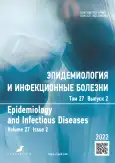Human dirofilariosis (D.repens) in the subcutaneous tissues of the head: Clinical case in the department of neurosurgery of the Interregional Clinical and Diagnostic Center of Kazan
- 作者: Pichugin A.A.1,2, Karimova E.R.1, Filimonova O.A.1, Koviazina R.R.3, Abdulkhaev F.A.1, Sharafutdinova V.I.1, Alekseev A.G.1,2, Khayrullin R.N.1
-
隶属关系:
- Interregional Clinical Diagnostic Center
- Kazan State Medical University
- Duke Kunshan University
- 期: 卷 27, 编号 2 (2022)
- 页面: 136-143
- 栏目: CASE REPORTS
- URL: https://journal-vniispk.ru/1560-9529/article/view/110862
- DOI: https://doi.org/10.17816/EID110862
- ID: 110862
如何引用文章
详细
Human dirofilariasis is a zoonosis caused by thin nematodes of Dirofilaria species (D. repens, D. immitis, D. tenuis and D. ursi) that belong to the Onchocercidae family. Larval stages of Dirofilaria usually occur in their primary hosts, such as cats and dogs, and rarely invade incidental hosts — human. The study described a clinical case of a patient with skull base meningioma who was admitted to the neurosurgical department for elective surgical treatment. The dense nodule was palpated in the subcutaneous tissue of the frontal area of the head. During the removal of the subcutaneous node, a thin white alive worm was evacuated during the surgery. The microscopical examination verified D. repens. Human dirofilariasis is a rare disease in the Republic of Tatarstan, Russia. However, the number of dirofilariasis cases is increasing in the recent years. Thirty-seven patients with dirofilariasis were diagnosed in the Republic of Tatarstan from 2010 to 2022.
作者简介
Arseniy Pichugin
Interregional Clinical Diagnostic Center; Kazan State Medical University
Email: arsenicus@yandex.ru
ORCID iD: 0000-0002-0134-1005
SPIN 代码: 7794-5270
Scopus 作者 ID: 57188870842
MD, Cand. Sci. (Med)
俄罗斯联邦, 12A, Karbysheva St., Kazan, 420101Elvira Karimova
Interregional Clinical Diagnostic Center
Email: erkar@mail.ru
MD, Cand. Sci. (Med)
俄罗斯联邦, KazanOlesia Filimonova
Interregional Clinical Diagnostic Center
Email: 1604filimonovao@gmail.com
俄罗斯联邦, Kazan
Renata Koviazina
Duke Kunshan University
Email: renata.koviazina@duke.edu
ORCID iD: 0000-0002-6165-3668
俄罗斯联邦, Kunshan
Farid Abdulkhaev
Interregional Clinical Diagnostic Center
Email: farid1113@mail.ru
俄罗斯联邦, Kazan
Valentina Sharafutdinova
Interregional Clinical Diagnostic Center
Email: vtina@mail.ru
俄罗斯联邦, Kazan
Andrey Alekseev
Interregional Clinical Diagnostic Center; Kazan State Medical University
Email: a.alekseev@list.ru
ORCID iD: 0000-0003-1227-8918
MD, Cand. Sci. (Med), Associate
俄罗斯联邦, Kazan; KazanRustem Khayrullin
Interregional Clinical Diagnostic Center
编辑信件的主要联系方式.
Email: arsenicus@yandex.ru
ORCID iD: 0000-0002-2160-7720
SPIN 代码: 1146-7585
MD, Dr. Sci. (Med.), Professor
俄罗斯联邦, Kazan参考
- Sergiev VP, Supryaga VG, Morozov EN, Zhukova LA. Human Dirofilariasis: diagnosis and the pattern of pathogen-host relations. Medical Parasitology and Parasitic Diseases. 2009;(3):3–6. (In Russ).
- Gaynutdinova RF, Tukhbatullin MG, Gilmullina FS, et al. Diagnostics of human dirofilariasis. Practical Medicine. 2012;56(1):123–126. (In Russ).
- Tabachnick WJ. Challenges in predicting climate and environmental effects on vector-borne disease episystems in a changing world. J Exp Biol. 2010;213(6):946–954. doi: 10.1242/jeb.037564
- Stryukova IL, Goncharova OV, Gulyantz VA. Dirofilariasis in ophthalmology. Bulletin of Ophthalmology. 2001;117(3):43–44. (In Russ).
- Simón F, Diosdado A, Siles-Lucas M, et al. Response to the Letter to the Editor regarding ‘Human dirofilariosis in the 21st century: A scoping review of clinical cases reported in the literature’ by Simón et al. (Transboundary and Emerging Diseases; 2021: http://doi.org/10.1111/tbed.14210). Transbound Emerg Dis. 2022;69(4):1668–1669. doi: 10.1111/tbed.14430
- Amato L. Curatonium Medicinalium Centura Septima, Thessalonicae Curationes Habitas Continens. Lyon: Rouillé, Guillaume; 1570. 348 p.
- Kondrashin AV, Morozova LF, Stepanova EV, et al. Anthology of Dirofilariasis in Russia (1915–2017). Pathogens. 2020;9(4):275. doi: 10.3390/pathogens9040275
- Kondrashin AV, Morozova LF, Stepanova EV, et al. Global Climate Change and Human Dirofilariasis in Russia. Int J Environ Res Public Health. 2022;19(5):3096. doi: 10.3390/ijerph19053096
- Kartashev V, Tverdokhlebova T, Korzan A, et al. Human subcutaneous/ocular dirofilariasis in the Russian Federation and Belarus, 1997–2013. Int J Infect Dis. 2015;33:209–211. doi: 10.1016/j.ijid.2015.02.017
- Simón F, Siles-Lucas M, Morchón R, et al. Human and animal dirofilariasis: the emergence of a zoonotic mosaic. Clin Microbiol Rev. 2012;25(3):507–544. doi: 10.1128/CMR.00012-12
- Akao N. Human dirofilariasis in Japan. Trop Med Health. 2011;39(1 Suppl. 2):65–71. doi: 10.2149/tmh.39-1-suppl_2-65
- Balendran T, Yatawara L, Wickramasinghe S. Human Dirofilariasis Caused by Dirofilaria repens in Sri Lanka from 1962 to 2020. Acta Parasitol. 2022;67(2):628–639. doi: 10.1007/s11686-022-00543-3
- Ermakova LA, Nagorny SA, Krivorotova EY, et al. Dirofilaria repens in the Russian Federation: current epidemiology, diagnosis, and treatment from a federal reference center perspective. Int J Infect Dis. 2014;23:47–52. doi: 10.1016/j.ijid.2014.02.008
- González-Miguel J, Akhmadishina LV, Ruzina MN, et al. Human seroprevalence data indicate other factors than climatic conditions influencing dirofilariosis transmission in the Russian Federation. J Helminthol. 2020;94:e195. doi: 10.1017/S0022149X20000760
- Simón F, Kramer LH, Román A, et al. Immunopathology of Dirofilaria immitis infection. Vet Res Commun. 2007;31(2):161–171. doi: 10.1007/s11259-006-3387-0
- Chistenko GN, Vedenkov AL, Dronina AM, Semizhon OA. Human Dirofilariasis. Medical Journal. 2013;45(3):30–33. (In Russ).
- Gushchina MB, Tereshchenko AV, Yuzhakova NS. Clinical forms of ocular dirofilariasis. Vestnik Oftalmologii. 2019;135(4):113–120. (In Russ). doi: 10.17116/oftalma2019135041113
- Pampiglione S, Rivasi F. Human dirofilariasis due to Dirofilaria (Nochtiella) repens: an update of world literature from 1995 to 2000. Parassitologia. 2000;42(3-4):231–254.
- Sergiev VP, Supryaga VG, Darchenkova NN, et al. Dirofilariosis in Russia. Epizootology, epidemiology and monitoring of parasitic diseases. 2012;(4):60–64. (In Russ).
- Prokhorenkov VI, Guzey TN, Ashmarina EM, et al. Dirofilariasis: two clinical cases. Klinicheskaya Dermatologiya i Venerologiya. 2015;14(5):32–37. (In Russ). doi: 10.17116/klinderma201514532-36
- Ksembaev SS, Ivanov OA, Torgashova OE, Khamitova AR. Subcutaneous dirofilariasis of maxillofacial localization — a rare clinical case. Kazan Medical Journal. 2018;99(5):829–832. (In Russ). doi: 10.17816/KMJ2018-829
- Kozlov SS, Vecmadyan OT, Mostovaya OT, Turicin VS. Ultrasonography as an effective diagnostic method for human subcutaneous dirofilariasis. Journal of Radiology and Nuclear Medicine. 2016;97(2):101–104. (In Russ). doi: 10.20862/0042-4676-2016-97-2-101-104
补充文件






